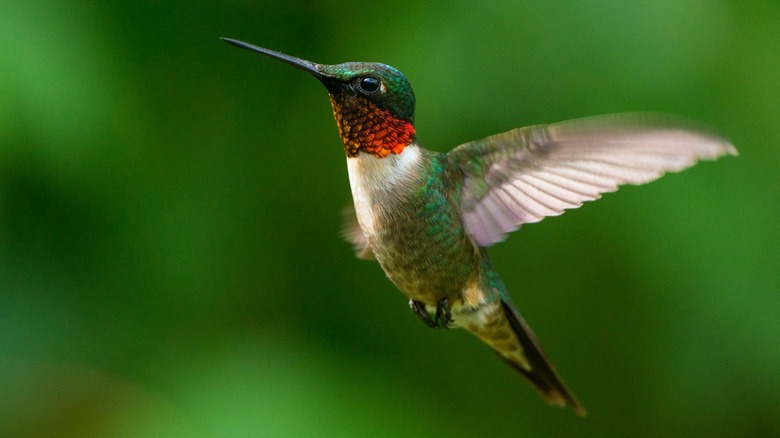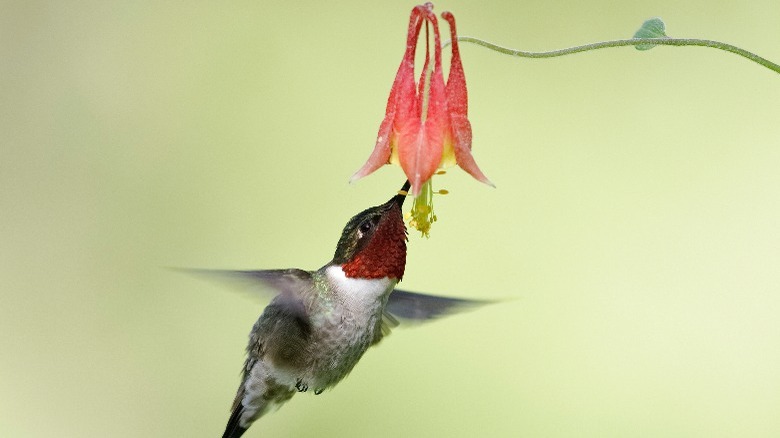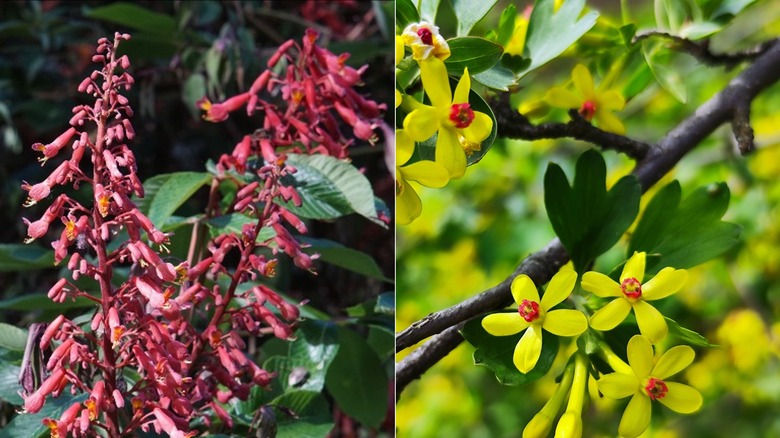The 3 Best Flowers For Attracting Ruby Throated Hummingbirds During Spring Migration
While planning your spring garden, imagine which creatures you want to visit. Whether you're looking to attract more songbirds with beautiful shrubs or some other winged friends, it's great to grow plants that coincide with their habits. Ruby throated hummingbirds find the most appeal in red and orange flowers with unique tubular shapes. The long beaks of these native hummingbirds allow them to easily retrieve the delicious nectar. It's likely this hummingbird species evolved alongside certain flowers, which accounts for the shape of species like red salvia (Salvia coccinea). You can take advantage of this evolutionary fun fact in your garden and choose flowers with long, tube-like shapes that hummingbirds enjoy.
If you hope to encourage ruby throated hummingbirds to stop in your yard on their way home, focus on flowers that bloom in early spring. Several flowers bloom about the same time as the spring migration, like columbine (Aquilegia canadensis), clove currant (Ribes aureum var. villosum), and red buckeye (Aesculus pavia). These flowering plants will make your home a veritable wonderland for hungry hummingbirds on their way home after a long winter retreat.
Native columbine offers a pop of red
Ruby throated hummingbirds enjoy red flowers, like the dangling ones that grow in spring on eastern red columbine. This columbine species is the only native species in North America, and is also called wild columbine. Although it is toxic to herbivores, its nectar is an important food source for ruby throated hummingbirds. If you are looking to welcome these bright-colored, native birds to your yard, consider growing red columbine.
The best part is that it's not hard to learn how to grow and take of the columbine flower. As long as you ensure it drains well, this flower will thrive in a variety of soils. It also requires very little maintenance, and while they prefer shady conditions, mature plants can tolerate full sun. If you have columbine seeds, you can get them started inside. However, cold, moist stratification is required for columbine, which means that the seeds must experience certain conditions before they germinate in the spring. Planting them outside in the fall allows this process to happen naturally, and is common among prairie natives like eastern columbine.
Plant these flowering shrubs for springtime visitors
For more genius tips and tricks to attract hummingbirds to your garden, consider planting the red buckeye or clove currant. The red buckeye is a flowering shrub (sometimes termed an understory tree) that is native throughout the eastern U.S. and as far west as central Texas. Bright red, tube-shaped flowers bloom in large stalk-like clusters. This shrub provides nectar around the time that ruby throated hummingbirds head back from wintering grounds, around March or April. Red buckeye is another example of a plant that requires seed stratification in the autumn. Get them started as soon as possible so they are ready to bloom from March to June.
Clove currant, or buffalo currant, is a deciduous shrub that features small trumpet-shaped flowers. These yellow buds have lovely red centers that hang in clusters off the branches. It grows well in sun or partial shade and may grow up to 8 feet tall. It is also native throughout most of the United States, except the southeast. This shrub flowers in mid-spring over a two-week period, making them the perfect choice for someone looking to appeal to ruby throated hummingbirds. Gardeners can also enjoy their special scent that combines cloves and carnations. Sowing clove currant and red buckeye seeds in your garden in the fall is a great first step to having beautiful flowers to attract ruby throated hummingbirds in the spring.


